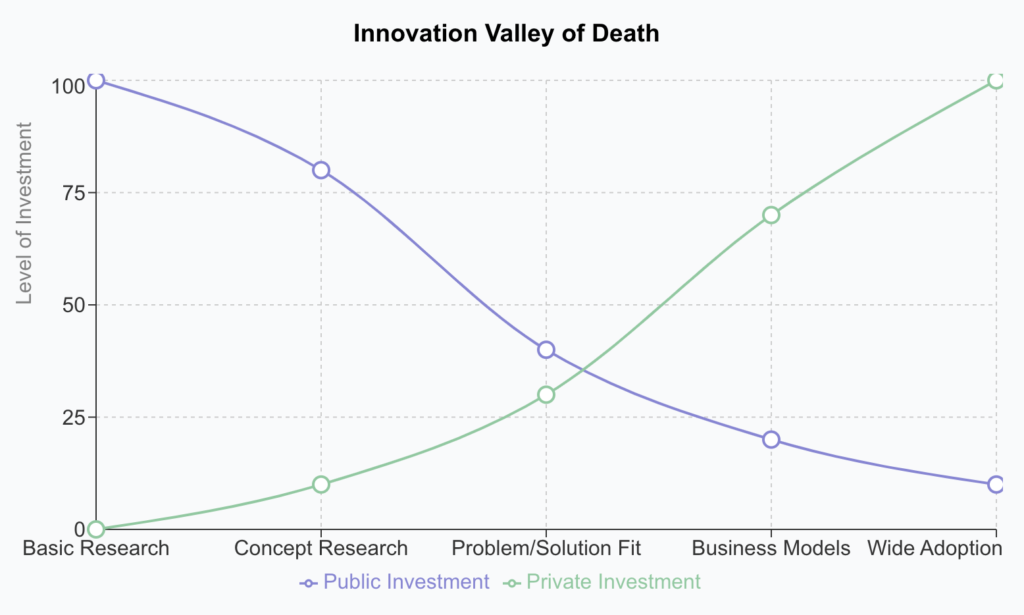Every year, thousands of groundbreaking ideas emerge from research labs and universities, brimming with the potential to reshape industries. Yet, a significant number of these innovations never see the light of day. They fall into the abyss ominously termed the “Valley of Death,” which, as a paper in Science Direct puts it, “is an unfavorable business condition that any new enterprise can witness during their early life cycle.”
Bridging the R&D Valley of Death
This chasm between discovery and commercialization represents the gap where public funding for academic research ends and private investment for product development begins—a gap that many promising technologies fail to bridge. Bridging this gap requires more than just funding; it demands a multidisciplinary approach that integrates diverse expertise from various fields.
Organizations like Stanford’s Innovative Medicines Accelerator (IMA), part of Sarafan ChEM-H (Chemistry, Engineering, Mathematics and Humanities), aim to translate academic discoveries into potential drugs or therapies that can attract industry interest. Led by Nobel Prize-winning chemist Caroline Bertozzi, Ph.D., the IMA’s overarching goal is to develop innovations through research to better human health.
We’re trying to build that bridge out of the valley. We collaborate directly with faculty on campus through requests for proposals. Our small team of about 10 people has the expertise to accelerate discovery to market, focusing on publications and patents.
Matt Armbrust, Research Associate in Protein Engineering at Sarafan ChEM-H | Stanford University.
While many professors and researchers excel in scientific discovery, the path to creating a market-ready product involves a different set of skills and experiences. “A lot of these professors have great science and do great research, but they don’t necessarily know how to make a drug,” Armbrust explains. “That’s where we step in.”

The problem is similar outside of drug discovery and development. Various estimates project that 90% of startups fail. But the challenge isn’t just related to early-stage companies. The aforementioned Science Direct article concluded that “most technology innovators face difficulties” in navigating factors like how businesses operate while also underestimating the difficulty in getting the technology to market.
The Power of Multidisciplinary Science
Bridging the “Valley of Death” requires harnessing the strengths of multidisciplinary science. “We’re disease agnostic, so we have a really wide range of projects—a very diverse portfolio,” Armbrust explains. “We don’t really limit who we collaborate with, as long as we see it as a feasible project where we can actually have an impact.” Their projects span from cancer targets to macular degeneration and COVID-19 research.
Jenny Hu, Head of Customer Success & Growth at Labstep, a STARLIMS company, observed that “the academic setting, it’s usually quite multidisciplinary, and there are definitely lots of pain points in that—at least when I was in the lab.” While multidisciplinary efforts can be challenging, they are essential for devising a concerted approach to match a product sketch to market needs and to ultimately navigate the hurdles to not only get it to the market but to outcompete rivals.
While collaboration may sound obvious, one hindrance to working together is the fragmentation of data. Researchers often juggle multiple systems—paper notes, Excel spreadsheets, Word documents, Slack messages, emails, and various cloud storage platforms. This fragmentation can hinder collaboration and make it difficult to track experiments from start to finish.
People are using more than five systems to document the start to finish of an experiment. When I say systems, it’s like paper, Excel, Word docs, Notion, Slack, email, Google Drive, SharePoint.
Jenny Hu, Head of Customer Success & Growth at Labstep, a STARLIMS company
So, How Do We Bridge the Valley?
Read the rest of the article by Brian Buntz, Editor-In-Chief of R&D World to discover…
- How fragmented data exacerbates the situation
- How to align teams, data, and technology to achieve success
Or, watch the webinar to learn more…


